| Feb-02-06 | | Autoreparaturwerkbau: Just too many weak squares by black. |
|
| Feb-02-06 | | Averageguy: Instructive endgame technique. |
|
Feb-05-06
 | | Mateo: 28... Kf8? was bad according to Timman. He thinks that Black may have big prospects of draw after 28... Ne6 29. Ne6 (otherwise 29. Nf5 Nc5, and White can make no progress) fe 30. f4 Kf7 31. Kf2 h6. But it seems to me that after 31. e4, Black has a difficult ending. |
|
Feb-05-06
 | | Mateo: Timman says that Black should have tried 29... h6 and 30... Ne6. But after 30. b4 Ne6, the trade of the Knights is not forced, because the Black Knight cannot go anylonger to c5. White can for instance play 31. Ne2. |
|
Feb-05-06
 | | Mateo: According to Timman if 36... d4 37. e4! with the threat 38. fe Ke5 39. Kc5 Bb3 40. Kb6, White wins. But Black can play 37... Bd7. If 38. fe? Ke5 39. Kc5 Bb5!, Black wins. So I think that Timman suggestion 37. e4? deserves a question mark. On the contrary, I would add an exclamation mark to 36... d4!. White should play 37. ed with a small edge.
I would add a question mark to 36... ef? which loses as Polugaevsky demonstrates convincingly. |
|
| Sep-01-13 | | Nerwal: The position after 49... ♗e4 is featured in one of Bent Larsen's books covering practical endgames. 50. f5! is really a text-book solution. At first I couldn't see how to continue after 50. f5 g5!? as the h pawn black gets cannot be stopped. Well, after 51. hxg5 h4 52. g6 ♔e7, 53. ♔e5! makes everything work for white : 53... h3 54. ♗e6! (or 54. f6+ ♔f8 55. ♗e6!) h2 55. f6+ and white mates, or 54... ♗xf5 55. ♔xf5! h2 56. ♗xd5. |
|
| Oct-10-17 | | Howard: This game was heavily analyzed by Timman in his classic The Art of Chess Analysis, but didn't I read somewhere once that he'd overlooked a couple things--which engines apparently had discovered? I realize this website is not a "research library", but perhaps someone could supply some info. Thanks ! |
|
| Oct-10-17 | | Olavi: In New in Chess 4/1986 Dvoretzky writes that "... it seems to me, carries the weakest commentary of the entire book." Timman had nothing to add. In particular MD had a long note on black's 13th move and Timman's suggestions, and that later 15...Ng4 would have been good. |
|
Mar-29-19
 | | manselton: Shereshevsky includes this ending in his <Endgame Strategy> Chapter 10 <Endings with an Isolated d-Pawn>. He picks it up after move 27 and uses some of Timman's comments, one of which I believe I have found a major flaw in and will give below. I think I agree with most everything Mateo has noted. 28.a5! 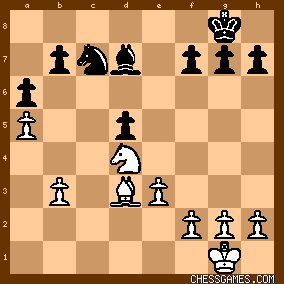
click for larger view <Fixing Black's Q-side Pawns as per standard practice.> He wrote earlier in the book that an isolated QP is just one weakness and this can usually be successfully defended. One more weakness makes it very difficult to defend. So after White's last move Black is in trouble. |
|
Mar-29-19
 | | manselton: 28...Kf8 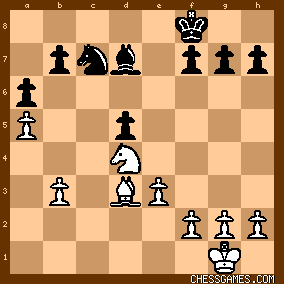
click for larger view <It is almost never wrong to centralize the King but it can be inopportune.> Shereshevsky agrees with Timman's thought that 28...Ne6 to unite the central pawns is better. However I have to side with Mateo (above) that it is much more difficult than that. |
|
Mar-29-19
 | | manselton: 30...g6?! 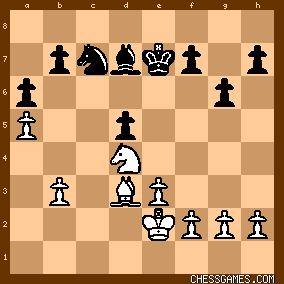
click for larger view <This mistake is so popular that there is no point in drawing attention to it each time.> Capablanca formulated the principle of pawn placement in these words <When your _opponent_ has a Bishop, keep your pawns on the squares of the same colour as this Bishop. But if _you_ have a Bishop, then, irrespective of whether or not the opponent has a Bishop, keep your pawns on squares of the opposite colour to that of your Bishop.> Even world class grandmasters fail to grasp this guideline. That's how Shereshevsky describes the fault as 'popular'. Placing his pawns on the same colour square as his Bishop makes is much harder to defend the position e.g by keeping the attacking King out. |
|
Mar-29-19
 | | manselton: 32.Nxe6?! A highly commital decision by Polugaevsky as it unites Black's central pawns. If the QP remained isolated this would be a winning plan, as all Black's pawns are on the same colour as his Bishop. 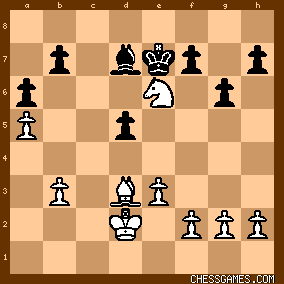
click for larger view <White could have played 32.Kc3 retaining all the advantages of his position. Timman gave the following interesting variations.> 32.Kc3 Nc5 33.Be2! Ne4+ a Pawn sac 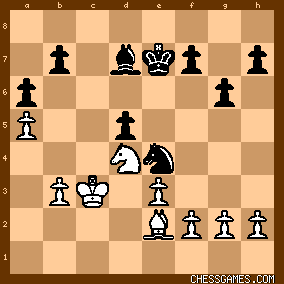
click for larger view And now 34.Kb4 Nxf2 35.Kc5 Ne4+ 36.Kb6 Nd6 37.Kc7 g5 38.Bf3 Be6 39.g4 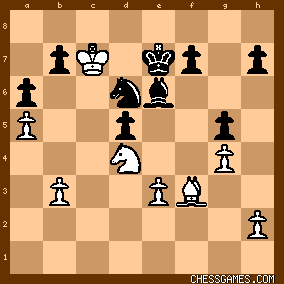
click for larger view Followed by Nf5+ after the tempo pawn moves are exhausted. (Have a good look at this position and you'll soon convince yourself Black is quite lost.) Or 35...Kd8 36.Kxd5 Kc7 37.Ke5 and White has won the pawn back while his King is rampant Black's position. (Note if Black had a pawn on f6 instead of g6 he holds out the White King.) 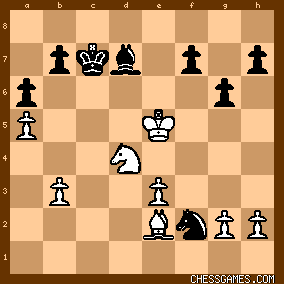
click for larger view Or 37...f5 38.Bf3 Be6 39.Ne2 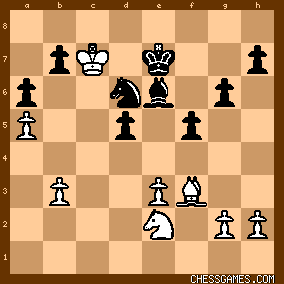
click for larger view Black's Knight must defend b7 and his Bishop d5. He's paralyzed, almost. White can take his time with b3-b4 and Nd4-b3-c5 |
|
Mar-30-19
 | | manselton: 32...fxe6 Taking with a piece is a positional blunder. 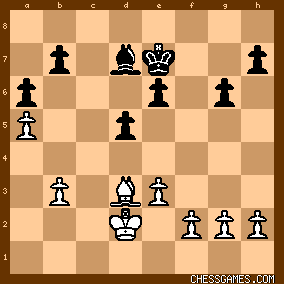
click for larger view |
|
Mar-30-19
 | | manselton: 33.f4 e5! 34.g3 Kd6 and Shereshevsky gives the last move a ? and remarks how natural the move is. 
click for larger view This judgment seems to rely on Timman's suggestion 34...Bb5 proving to be a draw but if Shereshevsky's quoted lines are correct this is dead wrong. The exchange of Bishops does only draw because White loses if he goes for the b5-pawn 35.Bxb5 axb5 36.Kc3 Ke6 37.Kb4? d4! -+ 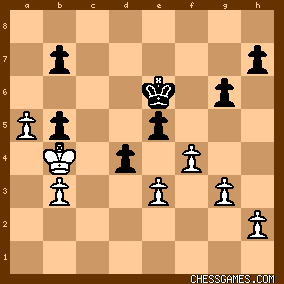
click for larger view Therefore on 34...Bb5 the white Bishop must retreat |
|
Mar-30-19
 | | manselton: Variation 34...Bxb5 35.Bc2 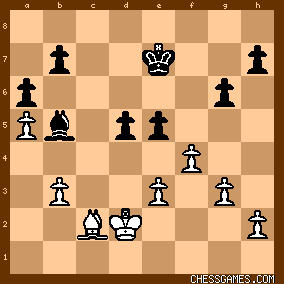
click for larger view And from here Timman gave a long analysis which Mecking would have been hard pushed to fathom over the board. 35...Kd6 36.Kc3 Be2 37.Bb1! Bf1 38.Kb4 d4! 39.exd4 exd4 40.Be4 Kc7 41.Kc5 d3 42.Kd4 d2 43.Bf3 b6! 
click for larger view From here Timman gave three possibilities a) 44.Kc3 bxa5 45.Kxd2 Bb5 46.Bd1 Kd6 47.Kc3 Kd5 48.Bc2 Bd7 <Black is not in danger of losing.> Shereshevsky b) 44.b4 bxa5 45.bxa5 Kd6 46.Kc3 Kc5 And Black regains his pawn c) 44.axb6+ Kxb6 45.Kc3 Kc5! 46.Kxd2 Kd4 <and despite his extra Pawn, White cannot win.> Shereshevsky *** 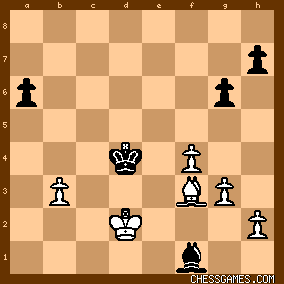
click for larger view
But this is Not true <47.Be2!> is a winning K+P ending or else White takes on a6. |
|
Mar-30-19
 | | manselton: Long analysis, wrong analysis is the quote on this site. |
|
Mar-30-19
 | | manselton: 35...Be6 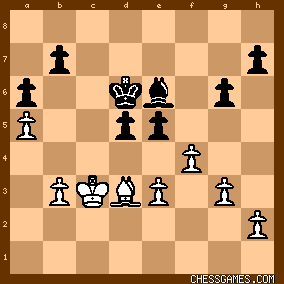
click for larger view With Black's King on d6 35...Bb5 36 Bxb5 axb5 37.Kb4 d4 is no longer possible as White can play 38.fxe5+ with check! |
|
Mar-30-19
 | | manselton: 36.Kb4 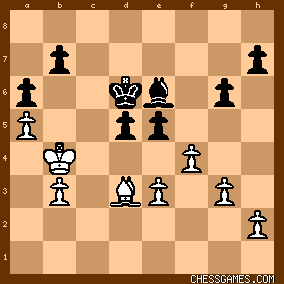
click for larger view And the threat of 37.fxe5+ Kxe5 38.Kc5 forces Black to concede the centre. The question is how? a) 38...e5-e5 can be dismissed on principle. The White King will invade c5 or e5. b) As Mateo says Polugaevsky convincingly refutes 38...exf4 and this leaves c) 38...d5-d4 as the last try. I think White wins by 39.Bc4 Bd5 then avalanching his K-side pawns down the board to promote the h-pawn. (Sac the f-pawn then the g-pawn and queen the h-pawn.) |
|
Mar-30-19
 | | manselton: 41...Bh1 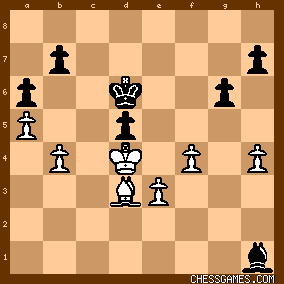
click for larger view <If Black leaves the long diagonal White wins by playing Bg2 then e3-e4 when Black's Bishop is on f7 or g8.> Shereshevsky |
|
Mar-30-19
 | | manselton: 47...h5 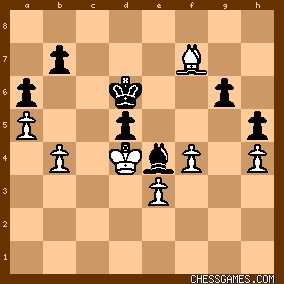
click for larger view <If it were Black to move it would be zugzwang.> |
|
Mar-30-19
 | | manselton: 50.f5! The decisive breakthrough. 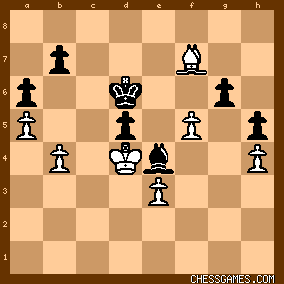
click for larger view <Now if> 50...gxf5 <a possible line is> 51.Bxh5 Ke6 52.Be2 Kf6 53.h5 Ke6 54.h6 Kf6 55.Bxa6! bxa6 56.b5 <White queens a Pawn.> 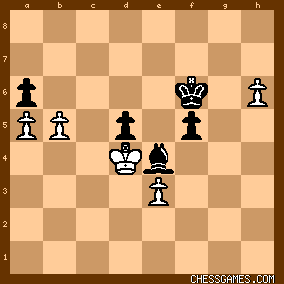
click for larger view |
|
Mar-30-19
 | | manselton: 52.e4 is another zugzwang. 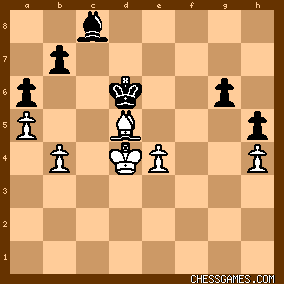
click for larger view The rest is straightforward. |
|





